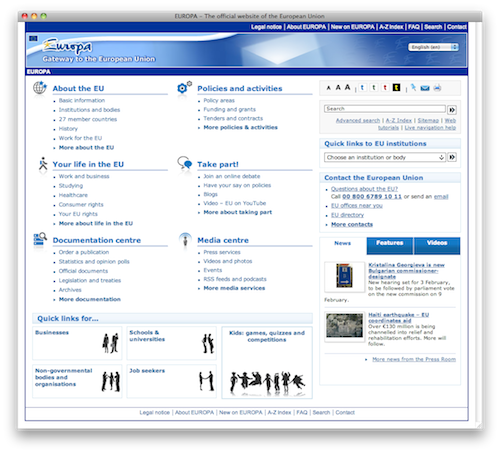Where does EU policy come from?
In my journey to learn more about the European Union (EU), I wanted to find out where EU policy comes from and how it is put into practice in the EU countries.
I decided to start with the Europa website. Europa, I discovered, is the official EU website. It took a lot of clicking around, but I found what I wanted eventually, and I know a lot more about the EU than I did yesterday.
The Europa front page has links to all sorts of interesting information. There are links to policy areas, consumer information, media, and official documents and legislation. Right at the top there is a Basic Information section. That looked like the place for me to start.
The Basic Information page was not what I was expecting. I expected the usual ‘about us’ page which would give me a bit of an overview and point me in the right direction for more information about how EU policies are created.
Instead, the Basic Information page had links to charts and graphs, slide presentations, and lessons. There was a link to EU fact sheets, which seemed like the best option. Sadly, the link took me to a notice saying the page no longer existed before redirecting me to a different web site, the European Parliament site.
On the European Parliament page, I noticed a section on the EU and its Institutions, which I though might help answer my questions. It turned out to be a list of recent articles and news items.
Having hit a dead end, I went back to the Europa Basic Information page. I clicked on the Panorama of the EU question and answer guide. I had avoided this link the first time because I generally don’t like the question and answer format.
The Panorama page was not your usual question and answer page. It read more like a corporate mission statement. Not particularly helpful. By this stage I was wondering, in frustration, why they didn’t have a summary that tells me what the EU actually does?
However, I did find my first useful snippet of information. There are 3 main EU institutions:
- European Parliament, which represents the people of Europe;
- Council of the European Union, which represents national governments;
- European Commission, which represents the common EU interest.
I wondered what they meant by the common EU interest. I assumed it was most likely their foreign affairs and trade section. I was soon to find out this assumption was wrong.
As I was about the leave the Panorama page, I noticed some more links off to the side. One of them was What do we do? Maybe that would have the information I was looking for.
The What do we do? page seemed to cover the EU’s key policy areas, but nothing about where the policy originates.
As an aside, I was interested to notice that environment and climate change each seem to be separate policy areas. I’ll keep them in mind to explore another day.
I was still no closer to answering my questions about where EU policies come from. There was another link off to the side titled How are we organised? It seemed worth a try, and I was rewarded with a first page that actually looked promising.
The How are we organised? page had a summary of nine EU institutions, including the three important ones I found earlier. And, finally, there were the answers to my questions about where EU policy comes from and how it is implemented.
The European Parliament has shared responsibility for passing European laws, based on proposals put forward by the European Commission. The European Parliament is elected by the people every five years.
The European Parliament shares responsibility for passing EU laws with the Council of the European Union. The Council of the European Union is comprised of ministers from the national governments of EU countries. They are responsible for EU foreign policy, security policy, defence policy, and justice and freedom issues.
Within the Council of the European Union, overall EU policy is set by the prime ministers and presidents of the EU countries.
The European Commission is responsible for drafting proposed EU laws, which are presented to the European Parliament and Council to be passed. They are also responsible for implementing EU policies, using EU funds, and enforcing EU laws.
It appears that EU policy originates in the Council of the European Union. The laws then need to be passed by the Council of the European Union and the European Parliament.
This process is roughly similar to the process in Australia, where new laws have to be passed by both houses of parliament.
Finally, EU policy and laws are all administered, implemented, and enforced by the European Commission, effectively the EU’s civil service.
